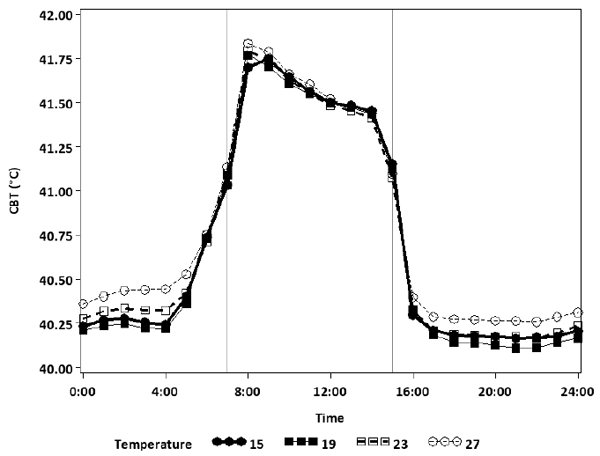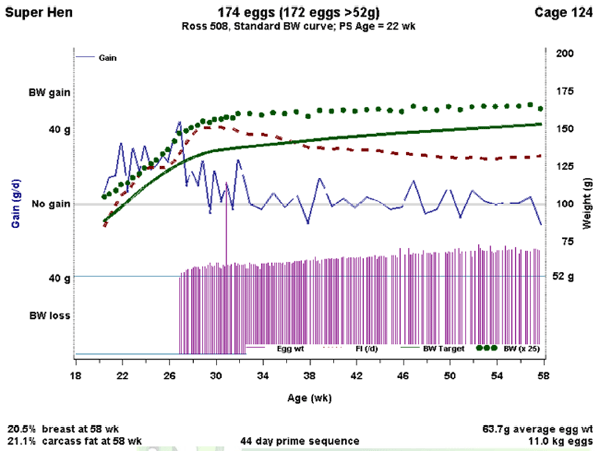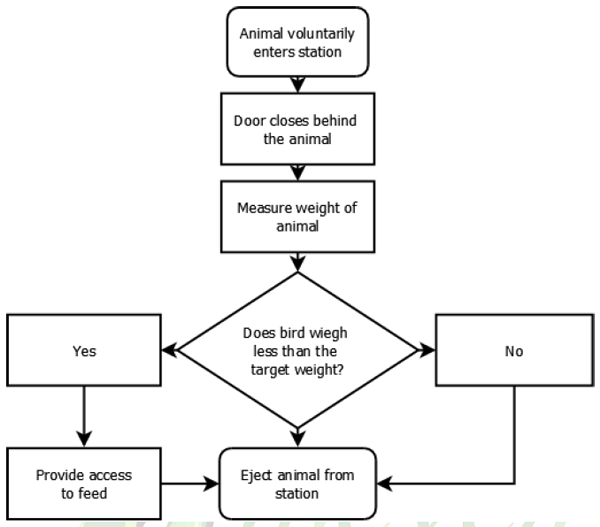Nutrient Requirements
A nutritionist’s goal is to match nutrient supply to the nutrient requirements of the flock. Therefore, feed allocation decisions for broiler breeders are driven by nutrient requirements. Ideally, feed would be allocated according to the needs of every bird. In reality, flock managers must still make feed allocation decisions according to the average bird.
Classically, a nutrient requirement is defined as the intake or dietary concentration of a nutrient that results in the maximum response. For broiler breeder hens, the response to nutrients is a complex and confounded issue because of the time lag between feeding a nutrient and seeing the result in performance (chick production). Recruitment and growth of ovarian follicles, mating success, embryo development, and hatching all separate the performance indicator (chicks) from the input (feed) by at least 4 weeks. In this time, many environmental factors can increase or decrease the breeders’ success. Effects of pullet and cockerel nutrition on chick production are even further confounded, since the pullets and cockerels consume feed for six months before the first chick is produced.
Energy partitioning
Maintenance. The metabolizable energy (ME) a broiler breeder consumes is partitioned to 3 main areas: maintenance, growth, and reproduction. Kleiber’s law relates maintenance energy to metabolic body weight, with values typically accepted within the range of 100 to 125 kcal/kg0.75. The coefficient and the exponent vary, and are often debated, and the values depend primarily on the metabolic state. This is partially a function of how fast an animal is growing, or how many eggs are being produced. The maintenance energy requirement (MEm) also depends on environmental temperature, light intensity and daylength, activity level, and immune status (Figure 1). Body composition, specifically the proportion of fat tissue (low MEm) and lean tissue (higher MEm) also affects the total amount of energy required for maintenance.
Production. Growth and reproduction have specific energy costs. The composition of gain (lean or fat) contributes to the energy requirement for growth, since fat has a much higher retained energy (approx. 9 kcal/g of fat) than lean tissue. Protein contains approximately 4 kcal/g (dry matter basis). Because lean tissue is 67% water, the retained energy of lean tissue on a whole body basis is closer to 1.5 kcal/g. Energy requirements for egg production are approximately 3.01, 0.47, and 0.08 kcal/g of yolk, albumen, and shell, respectively (McLeod et al., 2014). A typical value for egg production is 2.1 kcal/g of egg produced. Production levels are dynamic, and vary with age and level of production. Romero et al. (2009) developed empirical equations to predict energy requirements for maintenance, egg production and growth that varied with age. These variations are due to composition of production and of the body (body and egg components change with age).
Figure 1. Factors affecting nutrient use by broilers (left side) and broiler breeders (right side).
Genotype
Strain- and sex-related differences in growth and reproductive outputs also lead to variation in maintenance and production energy requirements. Differences in target BW curves primarily affect the energy requirement for growth. Modern breeders are feed restricted to a high degree, such that most of the energy requirement for maintenance and growth are related to lean tissue. Around puberty, hormonal changes in response to photostimulation of the hypothalamus around puberty cause an increase in fat deposition during this time in females. Biologically speaking, within-sex differences between strains are well explained by differences in body composition and the composition of gain and reproduction.
Environment
Immune response. The environment contributes primarily to differences in maintenance ME requirements (MEm). Inflammation, which is part of the innate immune response, can influence appetite. There is also an energetic cost associated with mounting a fever. Vaccinations constitute a considerable energy requirement, and feed allocation decisions should be more generous following vaccinations. Disease situations and even response to commensal bacteria have an energy cost, as well. Although well-accepted theoretically, there are few estimates of the actual energy cost of the immune response.
Nutrition. Dietary energy level itself contributes to energy requirements. Broiler breeders fed a low ME diet had a higher core body temperature, and subsequently lost more heat to their environment (Paul, 2013; ¡Error! No se encuentra el origen de la referencia.). This increased MEm. Feed allocation (kcal/bird) should be slightly higher with lower nutrient density diets. Romero et al. (2009) estimated that MEm increased 0.34 kcal per kcal of ME intake. The implication was that fully 1/3 of each additional kcal of energy consumed was lost as heat as dietary ME decreased.
Light. Light intensity and daylength can influence bird behaviour and physiology, and therefore nutrient requirements. High light intensity increases bird activity levels, and therefore increases the amount of activity-related heat production. Activity increases heat loss to the environment, and therefore increases MEm. Feed allocation should therefore be higher in environments with higher light intensity. Daylength influences the relative amount of time birds spend in a low or high activity state during night and day, respectively. Birds on a longer daylength have an elevated activity level for a longer period of time, and this increases the core body temperature (Figure 2 and ¡Error! No se encuentra el origen de la referencia.), heat loss to the environment, and therefore feed allocation needs to be higher when daylength is longer.
Figure 2. Diurnal core body temperature (CBT) patterns of broiler breeder hens (44 wk of age) fed high and low energy diets. Vertical reference lines in the graph indicate lights on at 05:30 and lights off at 21:30.

Light. Light intensity and daylength can influence bird behaviour and physiology, and therefore nutrient requirements. High light intensity increases bird activity levels, and therefore increases the amount of activity-related heat production. Activity increases heat loss to the environment, and therefore increases MEm. Feed allocation should therefore be higher in environments with higher light intensity. Daylength influences the relative amount of time birds spend in a low or high activity state during night and day, respectively. Birds on a longer daylength have an elevated activity level for a longer period of time, and this increases the core body temperature (¡Error! No se encuentra el origen de la referencia. and ¡Error! No se encuentra el origen de la referencia.), heat loss to the environment, and therefore feed allocation needs to be higher when daylength is longer.
Temperature. Environmental temperature also affects MEm. In adult breeders, the optimal environmental temperature (thermoneutral zone) is around 24°C (Paul, 2013). It is likely higher for pullets because the degree of feed restriction relative to growth and production potential is greater during rearing. Breeder pullets and hens grown in warmer environments (23 and 27°C) had higher core body temperatures during the night. Regulation of core body temperature in homoeothermic broiler breeders likely prevented a drop below those observed at 19°C and below (¡Error! No se encuentra el origen de la referencia.). Effectively, this increases the temperature differential between bird and environment, increasing heat loss and increasing MEm and required feed allocation in an increasing rate below 19°C.
Figure 2. Diurnal core body temperature (CBT) pattern of broiler breeder pullets (13 to 20 wk) in 15, 19, 23 and 27°C environmental temperature treatment. Vertical reference lines in the graph indicate lights on at 07:00 and lights off at 15:00.
So what? How do you allocate feed to broiler breeders?
Shorten your feedback loop. Feed allocation accuracy is improved when the time between BW measurements decreases. Weigh birds frequently (at least twice per week). In any system, increasing the time between consecutive feedback of information decreases the precision of the decision. Think about how often your eyes provide feedback to your brain. Driving a car is possible because your eyes provide rapid feedback (many images are processed every second). Think about how imprecise driving might be if you opened your eyes once per second, or once every 10 seconds. It would not be long before the car would drift out of the lane, or you would collide with the car in front of you. Not weighing birds is like driving with your eyes closed. Weighing birds more frequently is like opening your eyes more often. You can adjust your feed allocation by a smaller amount more often, and the BW curve is smoother. Weigh birds accurately. Duplicate your technique and protocol every time you weigh birds so that the consistency of your sample is good.
Consider key variables. There are a few variables that are really important for feed allocation decisions. Ironically, BW is not one of them. BW is important so that you can estimate the rate at which birds have been growing since the last time you measured BW. BW gain is much more important than BW per se.
- Average daily gain (ADG). Calculate the ADG since the last BW measurement.
- Target daily gain. Estimate the ADG desired in the next 7 to 14 days. This is the difference between the current BW and a future target BW. You can interpolate between target BW, or simply use a published weekly target BW and divide the total desired gain by the total number of days to the future BW target.
- Average daily feed intake (ADFI). Calculate how much feed you fed since the last time you measured BW and made a feed allocation decision. This is the ‘base’ from which you make your change.
- Estimate the change in feed allocation. The feed allocation should change based on the targeted change in gain. If ADG is lower than it should be to reach the target BW in 10 days, increase ADFI from the ‘base’ ADFI by 0.5 g of feed per g of gain needed. If the target BW gain needs to decrease, decrease ADFI by 0.25 g of feed per excess g of gain. These are rules of thumb, and the ‘science’ of feed allocation.
- Fine tune the ‘science’ with a little bit of ‘art’. There is also some ‘art’ in the feed allocation decision. Consider the last few feed allocation decisions. How did the birds respond to your last three decisions? There is often a lag in the response to a feed allocation change because keeping the feed allocation the same, or decreasing feed allocation can make birds more efficient. Increasing the feed allocation can make birds less efficient.
- IF YOU WEIGH BIRDS 2 OR 3 TIMES PER WEEK, don’t be afraid to decrease the feed allocation. This is a big ‘IF’!!! If you weigh birds often enough, the decrease will be for a very short time, and of little consequence. If you do not weigh birds often enough, feed allocation decreases will likely be disastrous.
Manage the feed distribution and uniformity
Qualitative restriction (diet dilution). It is very important to give all birds a great chance of eating their share of the feed allocation. Try to distribute the feed to the birds as uniformly as possible. Low dietary nutrient density is a good strategy, but it is of decreasing value as the gap between broiler growth potential and breeder BW targets increases. Feed dilution did little to improve BW uniformity in a recent trial. Holm (2010) decreased nutrient density by 25% by diluting a standard broiler breeder diet with ground oat hulls. In my laboratory, I increased the volume of a breeder diet by 400% by adding ground expanded polystyrene. Instead of consuming the daily feed allotment in 15 minutes, the birds consumed it in 20 minutes (Zuidhof, unpublished data). Even this radical qualitative restriction treatment did not improve uniformity.
Spin- or scatter-feeding. Pelleting a breeder diet and distributing it into the litter to increase the space and time required for birds to find their daily feed resulted in a modest but significant increase in flock uniformity (Holm, 2010). Other work (van Middelkoop, personal communication) has shown similar results. Interestingly, daily scatter-feeding reduced the recovery rate of Salmonella from the environment of broiler breeders relative to birds fed daily or every other day in a trough.
Grading. Many regions currently grade broiler breeders periodically during rearing to increase uniformity. This is an effective way to manage feed allocations according to the BW of groups of birds. By sorting birds into small, medium, and larger BW groups, multiple feed allocations can be applied within the same cohort to increase the growth rate of smaller birds, while decreasing the growth rate of larger birds. This has resulted in improved uniformity (Holm, 2010) and anecdotal reports of increased egg and chick production from the global hatching egg industry.
PRECISION FEEDING
Managing individuals
In my laboratory, we have been focusing more and more of our attention on the responses of individual broiler breeders to their environment and nutritional inputs. This has yielded insights that will be of great value for managing broiler breeder flocks in the future. One of the consoling trends we observed is that reproduction is a firmly entrenched biological priority. ¡Error! No se encuentra el origen de la referencia. shows that the rate of BW gain drops when egg production begins.
Figure 3. Analysis of individual hen records of performance has been instrumental in providing insights into individual responses to environmental and nutritional inputs.
At puberty, there is a biological shift in nutrient partitioning from growth to reproduction. Regardless of experimental treatments that have been applied, including BW profile, photostimulation age, strain, and environmental temperature, this effect was highly persistent (Zuidhof, unpublished data). This key biological priority suggests that as long as birds remain in a positive energy balance, BW profiles can be substantially altered with minimal impact on lifetime productivity. More research is needed to determine whether long-term increases in the BW profile (i.e. BW profiles that do not return to the current recommended target profile) are feasible.
The problematic gap
There is an increasing gap between the genetic potential of broilers for growth and the target BW of broiler breeders. The former has increased at a compounded rate of over 3% per year, and the latter has hardly changed since the late 1970s. As a result, competition for feed is intense in the pullet and cockerel barns, and flock uniformity is one of the biggest technical challenges faced by breeder technicians. This problem is not going to go away in the foreseeable future. It will only increase in intensity.
Precision feeding may be the way to manage broiler breeders in the future. The ultimate way to manage BW is to weigh every bird at the time a feed allocation decision is to be made. This has become reality with a new precision feeding system developed at the University of Alberta (Zuidhof et al., 2013; 2014). A simple algorithm moves the focus of breeder management from the feeding decision to BW (¡Error! No se encuentra el origen de la referencia.). Having rapid and frequent BW feedback on every bird every time it seeks a meal provides perfect clarity to the challenge of BW control.
Although a reality in a research environment, commercial precision feeding of broiler breeders is still some time off. A system that allocates feed to individual broiler breeders based on immediate feedback from individual BWs is an ideal way to control weight gains, and to provide nutrients to precisely match nutrient requirement. If the temperature drops, and MEm increases, every bird will receive just enough extra feed to compensate for the changing environment. If a bird lays an egg, it loses weight, and will receive extra feed that effectively replenishes the nutrients invested in the egg within hours of oviposition. If the nutrient density of the feed changes, birds will adjust their feed intake perfectly, maintaining a positive energy balance.
Figure 4. Precision feeding algorithm.
Proof of concept is complete. In a pilot study, precision feeding produced a small flock with a very high degree of uniformity (less than 3% CV). The system yielded novel insights into the performance and behaviour of individual birds in a manner never before achieved. If scale up is successful, precision feeding may revolutionize the management of broiler breeders.
References
Holm, D. E. 2010. Effects of maternal management and nutrition on broiler chicken carcass uniformity. MSc Thesis, University of Alberta.
McLeod, E. S., M. A. Jalal, and M. J. Zuidhof. 2014. Modeling ovarian follicle growth in commercial and heritage Single Comb White Leghorn hens. Poult. Sci. http://dx.doi.org/10.3382/ps.2014-04235.
Paul, D. C. 2013. Impacts of environmental temperature and dietary energy on core body temperature and efficiency in broiler breeder females. MSc Thesis, University of Alberta.
Romero, L. F., M. J. Zuidhof, R. A. Renema, A. Naeima, and F. E. Robinson. 2009. Characterization of energetic efficiency in adult broiler breeder hens. Poult. Sci. 88:227–235.
Wilson, K. M., B. L. McLendon, D. V. Bourassa, J. L. Wilson, N. A. Cox, and R. J. Buhr. 2013. Impact of skip-a-day and every-day feeding programs on the recovery of Salmonella and Campylobacter in litter of broiler breeder pullets. Poult. Sci. 92(Suppl. 1):13.
Zuidhof, M. J., A.G.C. DesLauriers, I. I. Wenger, C. J. Bench, C. O. Ouellette, and T. Gilmet. 2014. Precision broiler breeder feeding for stable metabolism and high flock uniformity. Poultry Sci. 93(Suppl. 1):225.
Zuidhof, M. J., I. I. Wenger, C. A. Ouellette, C. C. Kirchen, E.H.M. Lou, and M. V. Fedorak. 2013. Precision Broiler Breeder Feeding System Improved Body Weight Uniformity. Poultry Sci. 92(Suppl. 1):33.
This paper was presented at the XXXII International Poultry Seminar AMEVEA April 17-19, 2013, Bogota, Colombia.














.jpg&w=3840&q=75)